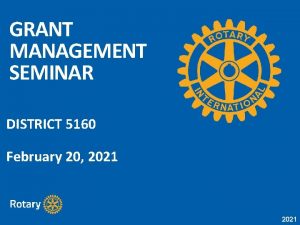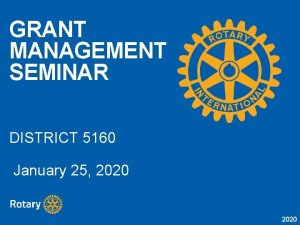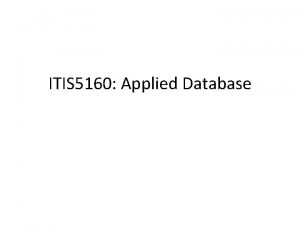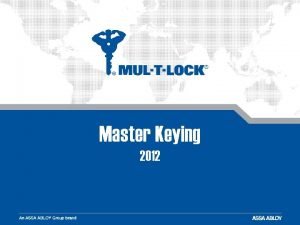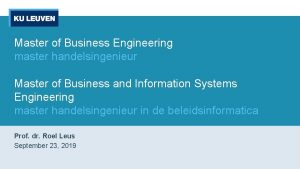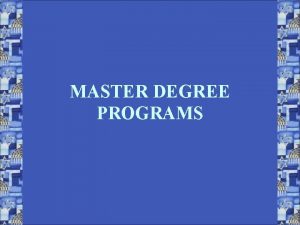IN 5160 Digital Leadership Leadership and Management Master














- Slides: 14

IN 5160 Digital Leadership – Leadership and Management Master in Digital Economy and Management January 2021

Learning outcomes • Explain the difference between leadership and management • Have an overview of (some) key theories • Explain transformation leadership • Understand new trends in theory: authentic leadership, ethical leadership, and servant leadership. 2

Leadership vs. management Leadership: Produces change and movement • Creates a vision and a strategy • Aligns people: teams, coalitions, alliances • Motivates and inspires Management: Produces order and consistency • Planning and budgeting • Organising and staffing • Controlling and problem solving Kotter on the difference: https: //www. youtube. com/watch? v=SEfg. Cqn. Ml 5 E 3

Peter Drucker on management • "Management is a multi-purpose organ that manages business and manages managers and manages workers and work. " • “Some people are thinkers. Some are prophets. Both roles are important and badly needed. But without followers, there can be no leaders» (Drucker, 1996). • Managing oneself: Self-management skills are the abilities that allow people to control their thoughts, feelings and actions. Peter Drucker 1909 -2005 4

Grint on Leadership Four research streams and ideal types: • • Leadership as position (where) Leadership as person (who) Leadership as result (what) Leadership as prosess (how) «The simplest definition of leadership: Having followers» Grint, K. (2010). Leadership: A very short introduction. Oxford University Press. 5

Traditional management theory 1. Plan what needs to be done and achieved 2. Organise the work in units and budget 3. Lead by inspiration and incentives 4. Follow-up organisational and economic results Follow-up Plan Lead Organise Bateman, Thomas S. , and Scott A. Snell. 1996. Management. Building Competitive Advantage. Chicago: Irwin. 6

Leadership styles: Transaction and transformation Transactional leadership Transformational leadership Source of authority Hierarchy Character, competence Follower attitude Compliance Commitment Rewards Pay Pride Time frame Short Long Style Command Role model Burns, J. M. (1978). Leadership. Harper Collins. 7

Servant leadership The Servant-Leader is servant first. . It begins with the natural feeling that one wants to serve, to serve first. Then conscious choice brings one to aspire to lead. . The best test, and difficult to administer is this: Do those served grow as persons? Do they, while being served, become healthier, wiser, freer, more autonomous, and more likely themselves to become servants? And, what is the effect on the least privileged in society? Will they benefit, or at least not further be harmed? (Greenleaf 1977: 7) Robert K. Greenleaf 1904 -1990 8

«Positive leadership» Authentic leaders are described as high on moral character and those who are “deeply aware of how they think and behave and are perceived by others as being aware of their own and others’ values/moral perspectives, knowledge, and strengths” (Avolio, Gardner, Walumbwa, Luthans, & May, 2004: 802). Ethical leadership is “the demonstration of normatively appropriate conduct through personal actions and interpersonal relationships, and the promotion of such conduct to followers through two-way communication, reinforcement, and decision-making” Hoch et al. (2016) 9

Scandinavian leadership Scandinavian leaders favour coaching rather than directing, frequently ask subordinates for opinions, are more willing to delegate decisions to subordinates than in many other nations and tend to favour team integration and team collaboration. • Focus on problem solving and learning • Trade unions Zander, L. : The Licence to Lead, An 18 -Country Study of the Relationship Between Employees’ Preferences Regarding Interpersonal Leadership and National Culture. In: Institute of International Business, Stockholm School of Economics, Stockholm (1997) 10

Many elements of management… Lars Erik Kjekshus 11

Leading change Kotter on change: The heart of change https: //www. youtube. com/watch? v= SEfg. Cqn. Ml 5 E John Kotter Harvard Business School 12

Exercise 1. Imagine that you are member of the top management group of Vi. PPS. Which matters will typically be leadership and which matters are management? 2. As a leader, can you choose freely between «traditional» transactional instrumental leadership and new transformational leadership styles, such as servant, authentic, ethical. . . ? 3. Does Scandinavian leadership work outside Scandinavia? 13

References • • • J. E. Hoch, W. H. Bommer, J. H. Dulebohn, D. Wu. (2016). Do ethical, authentic, and servant leadership explain variance above and beyond transformational leadership? A meta-analysis. Journal of Management (2016) (Avolio, Gardner, Walumbwa, Luthans, & May, 2004: 802). Grint, K. (2010). Leadership: A very short introduction. Oxford University Press. Greenleaf, R. K. 1977. Servant leadership: A journey into the nature of legitimate power and greatness. New York: Paulist Press. B. J. Avolio, W. L. Gardner, F. O. Walumbwa, F. Luthans, D. R. May. Unlo cking the mask: A look at the process by which authentic leaders impact follower attitudes and behaviors. The Leadership Quarterly 14
 Pxie-6358
Pxie-6358 Master class management
Master class management Digital goods ecommerce
Digital goods ecommerce Transactional leadership vs transformational leadership
Transactional leadership vs transformational leadership Data management roadmap
Data management roadmap Master data maestro
Master data maestro Apa yang dimaksud dengan warga digital?
Apa yang dimaksud dengan warga digital? Digital data digital signals
Digital data digital signals Digital data transmission
Digital data transmission E-commerce: digital markets, digital goods
E-commerce: digital markets, digital goods Digital data to digital signal encoding
Digital data to digital signal encoding Luxinnovation logo
Luxinnovation logo E-commerce digital markets digital goods
E-commerce digital markets digital goods Adaptive leadership style
Adaptive leadership style Enthusiastic beginner disillusioned learner
Enthusiastic beginner disillusioned learner


















